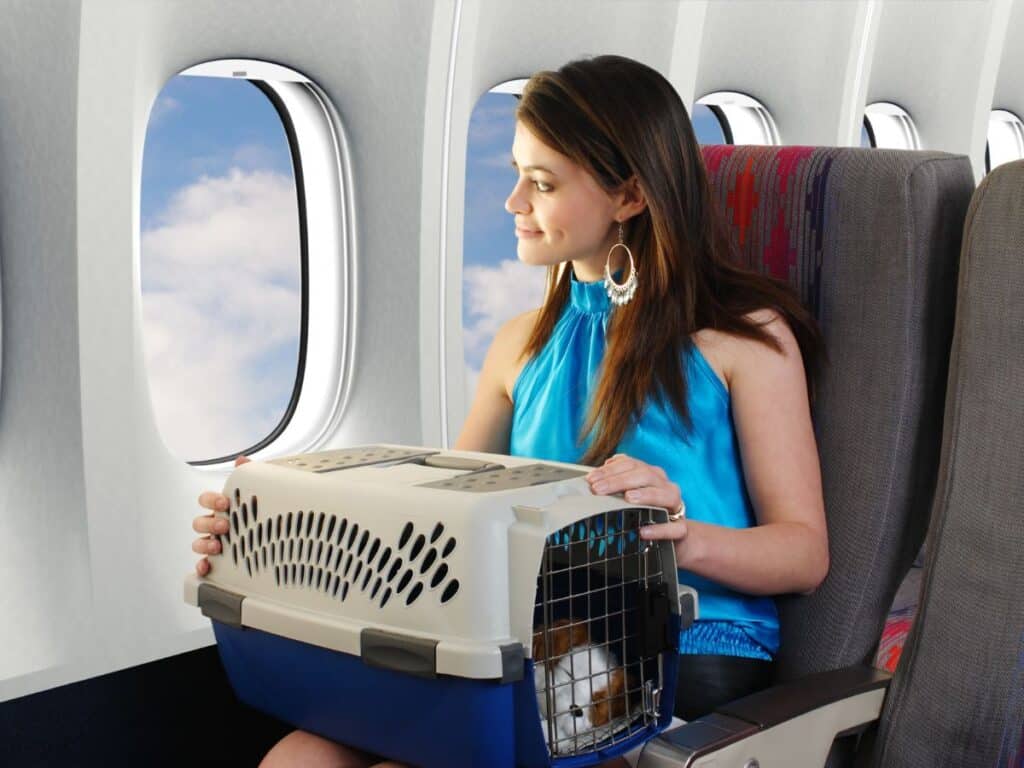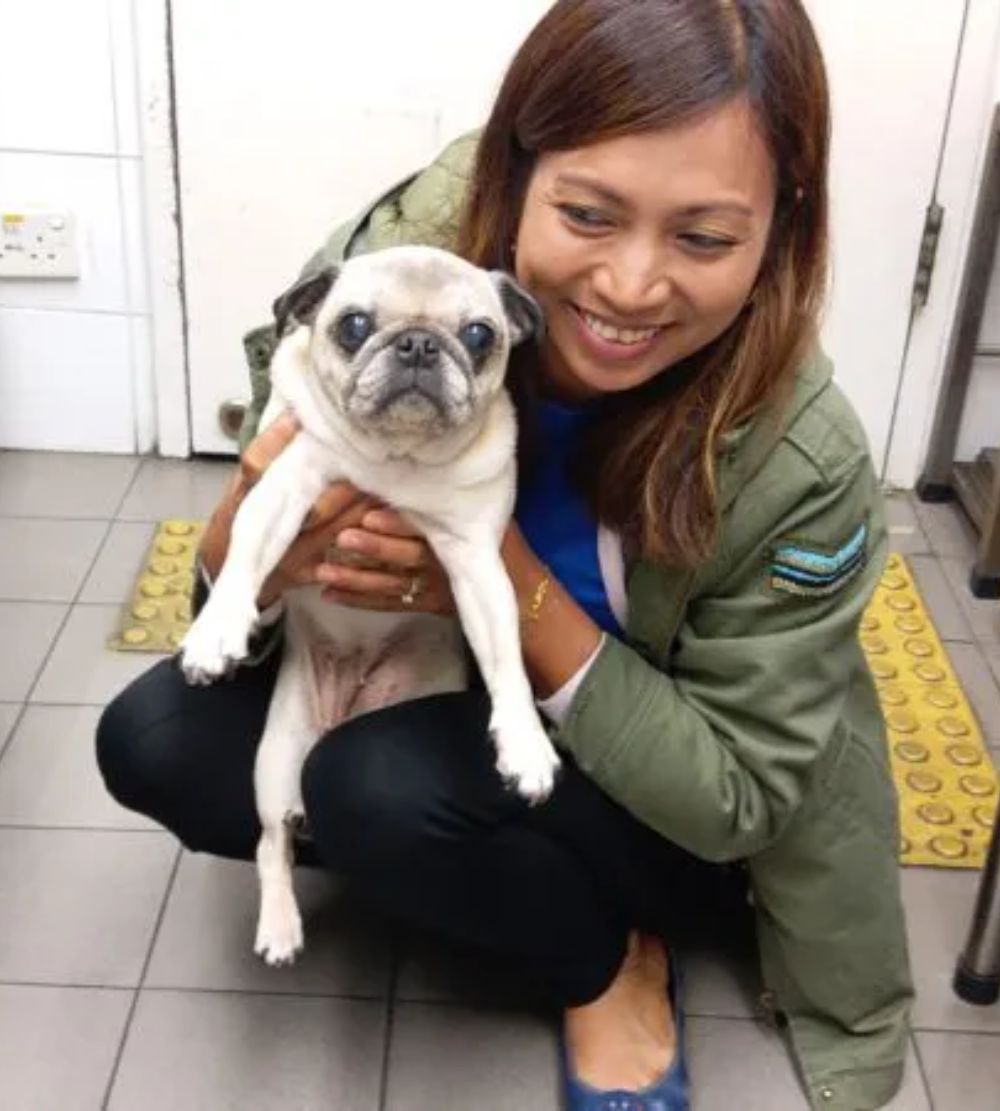Moving with your furry friend can be a joyful experience, but it requires careful planning and preparation. Navigating airports and ensuring your pet’s comfort is essential. Flying with a pet can be challenging, but with proper preparation, your furry companion can have a comfortable journey. As an international pet relocation agency with offices in Hong Kong and Singapore and experience of helping thousand of pets relocate we will provide you with some tips for flying with a dog in a cabin.
Understanding In-Cabin Travel
When you fly, your dog will be located in one of two places in the plane, either in the belly as special cargo or in-cabin with you. Choosing for in-cabin travel allows you to keep your pet close, providing comfort and reassurance throughout the journey. You will have a peace of mind knowing that your pet is comfortable and close to you throughout the journey. But there are some other factors to consider also so please read along with us!
Pro’s and con’s of bringing pets In-cabin
Flying in cabin with you will have pro’s and cons. Pro’s will be that you are together, and can monitor your pet closely. Con’s include the fact the bag limitation of size is very small for international travel, compared to the space in a rigid plastic or wood crate, i.e your pet can have more legroom in the hold. So there are a wide range of considerations to take into account.
Advantages of bringing pets In-cabin
- Reduced Stress for Pets: Traveling in the cabin with their owners can significantly reduce stress and anxiety for pets compared to being transported in the cargo hold. The familiar presence of their owner can have a calming effect on pets.
- Health Monitoring: Owners can monitor their pet’s health and behavior closely throughout the flight. They can ensure that the pet is hydrated, not overly stressed, and behaving normally.
- Convenience: It’s often more convenient for pet owners to have their pets nearby rather than going through the process of checking them in as cargo
- Immediate Attention: If a pet needs attention or is in distress, the owner can immediately notice and take appropriate actions, which is not possible if the pet is in the cargo area. (Saying that, it might be that you can’t do much other than pat them.)
Disadvantages of bringing pets In-cabin
- Space Constraints: In-cabin pet travel usually limits the size of the pet that can be accommodated. Pets need to be small enough to fit in a carrier under the seat, which is not feasible for larger animals.
- Strict Regulations and Fees: Airlines often have strict rules about the number, size, and type of pets allowed in the cabin. Additionally, there may be significant fees associated with in-cabin pet travel.
- Hygiene and Accidents: Pets might have accidents or cause messes in the cabin, as limited space, can cause embarrassment or upset.
- Limited Flight Options: Some airlines or specific flights (especially long-haul) may not allow in-cabin pets at all, limiting travel options for pet owners who wish to keep their pets close.
- Too much Public Interaction and distractions: Pets that are shy or aggressive benefit from the isolation of the cargo area, avoiding the stress of interaction with strangers. Some dogs might bark more on the plane but actually settle better and sleep in cargo.
- Harder for the pet to sleep- as no space in the bag and too many distractions.
When deciding between in-cabin and cargo travel for pets, it’s crucial to consider these factors along with the specific needs and temperament of the pet, as well as the regulations and facilities provided by the airline.
Understanding the Airline Policy
Airlines quite frequently may have restrictions on pet travel from time to time. This could be seasonal, may be to aircraft type on the selected route, or may be due to other individual airline factors.
The most important thing you should do is to confirm with your airline to ensure that your dog can fly with you in-cabin. The airlines will ask questions or ask you to provide you with detailed information relating to your dog’s age and the required documentation you need to bring with you. This may include immunizations, so make sure your dog is up-to-date on vaccinations before you travel. Also, you need to provide a recent health certificate from your dog’s veterinarian. Ensure everything is ready before travelling with your furry companion.
Book your flight Early.
The airline may allow only a limited number of pets on each flight. These pet seats may be granted on a first-come, first-served basis, so scheduling early can help avoid surprises. Also, some airlines may allow you to carry more than one pet into the cabin, but you may need to purchase additional empty seats to accommodate the pet carriers underneath. We recommend getting a flight ticket early for you and your pet to ensure you don’t have to settle for other options. We also recommend getting refundable tickets for incase you have to make some changes and hop to a different flight!
Plan for accident
Line the carrier with pee pads, and make sure you bring poop bags with you. Bringing poop bags is also essential for handling waste during emergencies. These steps can indeed help reduce stress and ensure you’re prepared for unexpected situations when travelling with pets. Many of the airports may not have pet toilets so come prepared. Also be aware that one loose pet running around an airport could result in that airport banning pets so please be very safe and careful with your pets not getting off leash, both for your own pet’s individual protection, but also to maintain the good name of pets travelling on planes!
Prepare and Follow the Packing Checklist
Create a checklist to ensure you pack all the necessary items for your dog’s comfort and well-being. Include essentials such as:
Leash: Bring a leash to keep your dog safe and under control during walks. Airports are busy places, and you want your dogs to be as close to you as possible. On the whole you will likely just need to carry your dog or keep them in the bag, but have a leash with you for if you find a place for a leg stretch for your dog.
Water bowl: Pack a collapsible water bowl for your dog to drink from while on the go. Hydration is very important during long travels.
Food: Don’t forget your dog’s regular food and treats to keep them satisfied and happy. We don’t recommend giving pets much or any food pre- or during travel, but have treats available for calming effect, and also food for once landed.
Medications: Bring any medications your dog needs, along with instructions for dosage. Make sure to regularly check up on your dog during the flight. Many people who fly with pets in-cabin do it because of concerns with elderly pets on medications, so bring along those meds that your dog takes daily.
Blanket: Pack something soft for your dog to rest on during the journey.
Toys: Bring along a few favourite toys to keep your dog entertained and comfortable. Dont bring any choking hazards, anything smelly or squeeky toys to irritate other passengers.
Waste bags: Be prepared to clean up after your dog with waste bags. Make sure to dispose of them properly.
Health documents: Carry your dog’s health records and vaccination certificates along with you. These documents are required at the time of boarding and arrival.
Keep these items in your carry-on bag so you can easily access them whenever your dog needs them.
Optimize Your Flight Route
If you want to fly with your dog in-cabin, you would need to pick a flight route that allows in-cabin travels. Sadly this might be the longer option with transits, depends on the airline rules.
A good reason to fly cargo alternatively, is that the flight might be more direct! Long transits can be very tiring for you and your dog. So the perceived benefit of ‘in-cabin’ maybe not worth it if a longer trip and more noisy take-off’s and landings?
Understand Country-Specific Requirements
The entry requirements for pets for both Hong Kong and Singapore (where we have offices), are different. In Fact every country has slightly different entry requirements for dogs . Ask us, or try and understand the necessary vaccinations, quarantine rules, and any specific health certificates required by each country. These requirements are crucial to ensure a smooth entry process for your dog.
Consider your Dog’s Meals
Avoid feeding your dog on the morning of the flight to prevent airsickness. This reduces the risk of digestive issues during travel.
Weather Considerations for Travel
When you’re travelling with your dog, it’s important to consider the climates of both your starting point and your destination. Just like us, Pets can also be affected by changes in temperature and weather conditions.
If you’re moving to a colder one, you must pack accordingly for your pet. For example, if you’re travelling from Hong Kong or Singapore to European countries in the Winter, make sure to bring a cozy sweater or jacket to keep your pet warm during walks or outdoor activities after you arrive. You can also pack some booties to protect your pet’s paws from the cold.
On the other hand, if you’re travelling to a hotter climate place, for example, moving to Singapore or Hong Kong; or moving to Middle Eastern countries like UAE, Qatar, etc., then be sure to pack plenty of water to keep your pet hydrated, especially if they’re not used to the heat. Make sure to only get out for walks during the mornings and evenings when the temperature is a bit cool. In any case. It’s always a good idea to check the weather forecast for your pet relocation destination ahead of time so you can pack properly.
Arrange Post-Flight Transportation
When you arrive at your destination, make sure the local road transportation you arrange is comfortable and safe for your dog. The taxi or delivery service at the other end. Check the rules about bringing pets on public transport to avoid any problems when entering or leaving the country.
Conclusion
Flying with your dogs requires careful planning and preparation to ensure a smooth and comfortable journey for both you and your pet. Understanding airline policies and requirements is essential, including any necessary documentation and health checks for your dog. Remember, prioritizing your dog’s safety and comfort is most important throughout the entire journey, from pre-flight arrangements to post-flight transportation. By following these tips, you can make flying with your dog in-cabin a positive and memorable experience for you and your furry companion.



